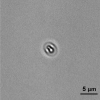Real-time monitoring of the dynamics and interactions of bacteria and the early-stage formation of biofilms
- PMID: 36307497
- PMCID: PMC9616909
- DOI: 10.1038/s41598-022-22669-0
Real-time monitoring of the dynamics and interactions of bacteria and the early-stage formation of biofilms
Abstract
Bacterial biofilms are complex colonies of bacteria adhered to a static surface and/or one to another. Bacterial biofilms exhibit high resistance to antimicrobial agents and can cause life-threatening nosocomial infections. Despite the effort of the scientific community investigating the formation and growth of bacterial biofilms, the preliminary interaction of bacteria with a surface and the subsequent early-stage formation of biofilms is still unclear. In this study, we present real-time, label-free monitoring of the interaction of Escherichia coli and Pseudomonas aeruginosa bacteria with untreated glass control surfaces and surfaces treated with benzalkonium chloride, a chemical compound known for its antimicrobial properties. The proof of principle investigation has been performed in a standard inverted optical microscope exploiting the optical phenomenon of caustics as a tool for monitoring bacterial diffusion and early adhesion and associated viability. The enhanced resolving power of the optical set-up allowed the monitoring and characterization of the dynamics of the bacteria, which provided evidence for the relationship between bacterial adhesion dynamics and viability, as well as the ability to form a biofilm. Viable bacteria adhered to the surface exhibited noticeable sliding or rotary dynamics while bacteria killed by surface contact remained static once adhered to the surface. This difference in dynamics allowed the early detection of biofilm formation and offers the potential to quantify the efficiency of antimicrobial surfaces and coatings.
© 2022. The Author(s).
Conflict of interest statement
The authors declare no competing interests.
Figures















Similar articles
-
Effect of antimicrobial residues on early adhesion and biofilm formation by wild-type and benzalkonium chloride-adapted Pseudomonas aeruginosa.Biofouling. 2011 Nov;27(10):1151-9. doi: 10.1080/08927014.2011.636148. Biofouling. 2011. PMID: 22098457
-
Decreased bacterial adherence and biofilm growth on surfaces coated with a solution of benzalkonium chloride.J Endod. 2012 Jun;38(6):821-5. doi: 10.1016/j.joen.2012.03.012. Epub 2012 Apr 25. J Endod. 2012. PMID: 22595118
-
Effect of chlorhexidine and benzalkonium chloride on bacterial biofilm formation.Lett Appl Microbiol. 2007 Dec;45(6):652-6. doi: 10.1111/j.1472-765X.2007.02249.x. Epub 2007 Oct 17. Lett Appl Microbiol. 2007. PMID: 17944843
-
Inhibition of Bacterial Biofilm Formation by Phytotherapeutics with Focus on Overcoming Antimicrobial Resistance.Curr Pharm Des. 2020;26(24):2807-2816. doi: 10.2174/1381612826666200212121710. Curr Pharm Des. 2020. PMID: 32048958 Review.
-
Recent perspectives on the molecular basis of biofilm formation by Pseudomonas aeruginosa and approaches for treatment and biofilm dispersal.Folia Microbiol (Praha). 2018 Jul;63(4):413-432. doi: 10.1007/s12223-018-0585-4. Epub 2018 Jan 19. Folia Microbiol (Praha). 2018. PMID: 29352409 Review.
Cited by
-
An astrobiological perspective on microbial biofilms: their importance for habitability and production of detectable and lasting biosignatures.Appl Environ Microbiol. 2025 Mar 19;91(3):e0177824. doi: 10.1128/aem.01778-24. Epub 2025 Feb 10. Appl Environ Microbiol. 2025. PMID: 39927769 Free PMC article. Review.
-
Regulatory Effects of RNA-Protein Interactions Revealed by Reporter Assays of Bacteria Grown on Solid Media.Biosensors (Basel). 2025 Mar 8;15(3):175. doi: 10.3390/bios15030175. Biosensors (Basel). 2025. PMID: 40136972 Free PMC article.
-
Uncovering bacterial-mammalian cell interactions via single-cell tracking.BMC Biol. 2024 Nov 11;22(1):256. doi: 10.1186/s12915-024-02056-z. BMC Biol. 2024. PMID: 39523331 Free PMC article.
-
Improving antibacterial ability of Ti-Cu thin films with co-sputtering method.Sci Rep. 2023 Oct 3;13(1):16593. doi: 10.1038/s41598-023-43875-4. Sci Rep. 2023. PMID: 37789153 Free PMC article.
References
Publication types
MeSH terms
Substances
LinkOut - more resources
Full Text Sources
Molecular Biology Databases

